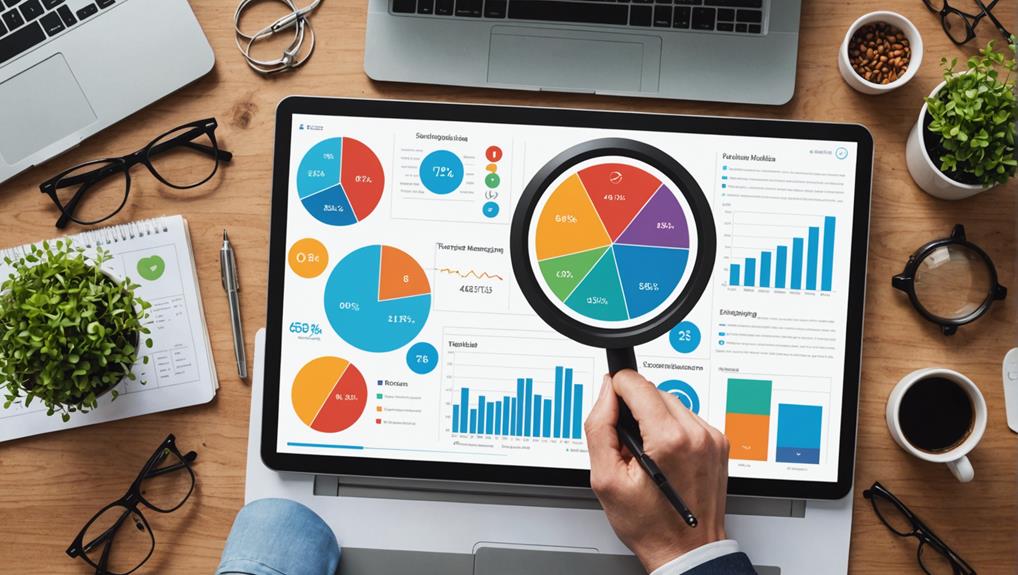Negotiating Instagram influencer deals involves a strategic blend of compensation types and well-structured agreements. Begin with clear budget constraints and understand industry benchmarks to set realistic financial expectations. Utilize product seeding for cost-effective entry and explore flat rate or commission-based models tailored to influencer impact. Prioritize flexibility, such as offering discounts for multiple posts, to maximize budgets. Establish engagement benchmarks and specify deliverables to guarantee alignment and accountability. Engage in discussions about non-monetary perks like exclusive access to bolster partnerships. Fostering transparency and collaboration leads to successful long-term relationships. Gain deeper insights into optimizing these negotiations by exploring further.
Key Takeaways
- Clearly communicate budget constraints early to foster transparency and guide discussions on deliverables.
- Utilize industry compensation benchmarks to set realistic financial expectations during negotiations.
- Explore discounts for multiple posts to maximize marketing budgets and enhance cost-effectiveness.
- Incorporate non-monetary incentives, like exclusive product access, to strengthen influencer partnerships.
- Establish clear engagement benchmarks tailored to campaign objectives for aligned expectations and measurable success.
Understanding Compensation Types
Compensation structuring is a pivotal aspect of negotiating Instagram influencer deals, demanding an analytical approach to balance cost-efficiency and campaign effectiveness. Brands must strategically select between product seeding, flat rate, and commission models to align with marketing goals and budget constraints.
Product seeding stands out as a cost-effective strategy, allowing brands to provide free products to influencers for content creation. This method not only minimizes initial expenses but also enables brands to gauge influencer compatibility before committing to monetary compensation.
The flat rate model, or pay-per-post, involves setting a predetermined fee for content creation, with influencer rates depending largely on audience size and engagement. Larger influencers command higher fees due to their extensive reach, making this model suitable for brands seeking to maximize visibility.
In contrast, commission-based compensation is particularly advantageous for driving sales conversions, offering influencers a percentage of the revenue generated from their posts. This model is popular among micro-influencers who prioritize authenticity and engagement over sheer follower count, greatly lowering upfront costs.
Ultimately, understanding and leveraging these compensation types is essential for crafting mutually beneficial partnerships that meet both brand objectives and influencer expectations.
Product and Fee Structures
In the dynamic landscape of influencer marketing, structuring product and fee arrangements requires a strategic blend of creativity and financial acumen.
Product seeding offers a cost-effective entry point, enabling brands to provide free products to influencers, thereby evaluating the brand fit and content quality before committing to monetary compensation. This approach aligns well with a cautious marketing budget, allowing for an initial, lower-cost investment that can yield high returns regarding authentic content and brand alignment.
When influencers charge for their services, understanding fee structures is vital. Micro-influencers typically demand between $250 to $1,000 per post, while more prominent influencers require higher fees reflective of their expansive reach and engagement capabilities.
Brands must skillfully negotiate with influencers to strike a balance between exposure and expenditure.
Furthermore, offering discounts for multiple posts, as 71% of influencers are open to, allows brands to maximize their marketing budget by engaging in bulk agreements.
Clearly defining compensation models—whether opting for a flat fee, product seeding, or a combination—enables brands to structure deals that are both cost-efficient and result-oriented, fostering long-term, mutually beneficial partnerships with influencers.
Commission-Based Campaigns
Shifting from traditional product and fee arrangements, commission-based campaigns present an innovative strategy for brands seeking to optimize their influencer marketing efforts. This model, functioning on a profit-sharing or affiliate basis, aligns brand and influencer interests by directly tying compensation to sales conversions.
For influencers, earning a percentage of sales generated through their promotional activities offers a compelling incentive to enhance engagement rates and drive conversions. This mutually beneficial framework encourages genuine endorsements, as authenticity becomes paramount; consumers are more likely to react favorably to sincere recommendations over overtly commercial messages.
Commission-based campaigns particularly resonate with micro-influencers and brand ambassadors, who are known for their niche audiences and deep-rooted connections with followers. These smaller-scale influencers often cultivate higher trust levels, which can translate into more effective conversions.
Additionally, the potential for long-term partnerships increases, as both parties stand to gain from the sustained success and shared objectives in boosting revenue. This model fosters a symbiotic relationship, where the influencer’s credibility aids in product promotion, while brands benefit from minimized upfront costs and enhanced marketing ROI.
Ultimately, commission-based campaigns represent a strategic evolution in influencer marketing, driving both engagement and financial outcomes.
Budgeting Considerations
Effective budgeting is a cornerstone of successful influencer marketing campaigns, demanding a strategic approach that aligns financial resources with campaign objectives. Understanding industry benchmarks is essential, as 50% of influencers charge between $250 and $1,000 per post. This insight aids in setting realistic financial limits within a brand’s budget, ensuring that influencer contracts align with financial expectations.
By considering common compensation structures—such as flat rates, flat rates combined with commission, and retainers—brands can tailor their budgeting considerations to match specific campaign goals.
Incorporating flexibility into the budgeting strategy can lead to more cost-effective outcomes. For instance, research indicates that 71% of influencers are open to offering discounts for multiple posts. This presents an opportunity to maximize budget efficiency and foster long-term partnerships.
Transparency regarding budget constraints during negotiations can also be beneficial, as it encourages influencers to propose cost-effective solutions, such as discounts or bundled deals.
Furthermore, conducting influencer interviews can provide valuable insights into realistic compensation expectations. This approach facilitates effective budget planning and informed influencer selection, ensuring that the influencer marketing strategy remains both financially sustainable and aligned with overarching campaign objectives.
Strategic Negotiation Preparation
In preparing for influencer negotiations, it is essential to define budget constraints clearly while setting realistic engagement expectations to guide the conversation.
By aligning financial limitations with campaign objectives, businesses can present transparent offers that respect both fiscal responsibility and influencer value.
Additionally, understanding industry compensation benchmarks allows for informed discussions, ensuring that proposals are both competitive and appealing to influencers.
Define Budget Constraints
When preparing to negotiate Instagram influencer deals, it is essential to establish clear budget constraints by leveraging industry benchmarks and data tools. Defining budget constraints involves understanding the financial parameters that guide influencer deals, ensuring alignment with campaign goals and audience size. Industry data indicates that 50% of influencers charge between $250 and $1,000 per post, with variations based on content type and engagement levels. This insight forms the baseline for setting realistic financial expectations.
Engaging in influencer interviews can provide further negotiation tips by revealing compensation norms, helping to refine budget constraints. Being transparent about financial limits not only enhances communication but also increases the likelihood of securing discounts or bundled deals, as 71% of influencers are amenable to such arrangements for multiple posts.
| Budget Strategy | Insights & Application |
|---|---|
| Research Benchmarks | 50% charge $250-$1,000/post; adjust for audience size |
| Transparency | Encourage discounts/bundles with open discussions |
| Influencer Interviews | Gain insights on compensation expectations |
| Data Reports & Tools | Select influencers aligning with financial limits |
Ultimately, clearly defined budget constraints streamline negotiation processes, ensuring that discussions remain productive and focused, minimizing misalignment in expectations and deliverables.
Set Engagement Expectations
Although setting engagement expectations might seem straightforward, it demands a strategic approach to align both parties on measurable success criteria.
Clear communication about desired metrics—such as likes, comments, and shares—is vital in negotiations to guarantee the influencer’s audience aligns with campaign goals. Influencers’ past performance offers a realistic foundation for setting these expectations, particularly given that typical engagement rates vary between 1% and 3%, contingent on follower count. This data serves as a guideline, making certain that targets are not only ambitious but also achievable.
Industry benchmarks can further inform these discussions, providing a reference to gauge the viability of proposed engagement commitments.
It is essential to tailor these expectations to the specific objectives of the campaign—whether the focus is on brand awareness or direct conversions, as each goal necessitates a different engagement strategy. This tailored approach assures that both the brand and influencer are aligned in their efforts.
Initiating Negotiations
Initiating a successful negotiation with an Instagram influencer begins with a strategic approach that balances transparency and flexibility. The first step is to inquire about the influencer rates, which lays the groundwork for a clear and focused discussion.
By understanding their baseline, you can effectively negotiate adjustments to the scope of work or propose alternative deliverables without exceeding your budget constraints. Communicating your budget early in the process fosters an atmosphere of openness and encourages influencers to contemplate flexible arrangements that align with mutual goals.
Being prepared with industry data further strengthens your negotiating position. Significantly, 50% of influencers charge between $250 and $1,000 per post. This information can guide you in setting realistic expectations and identifying opportunities where influencers might adjust their standard rates in exchange for a more tailored scope of work.
Negotiation extends beyond price, encompassing aspects like post frequency and content variety, which can be adjusted to meet both parties’ needs.
Maintaining a collaborative tone is essential. Emphasize mutual benefits to create a positive negotiating atmosphere, ensuring both parties feel valued and understood.
This strategic approach not only facilitates successful negotiations but also builds sustainable partnerships.
Enhancing Outcomes With Perks
Negotiating successfully with Instagram influencers involves more than just determining financial terms; it extends into the domain of building value through strategic perks. Offering non-monetary incentives such as exclusive product access, VIP experiences, or personalized gifts can greatly enhance the appeal of partnerships.
These tailored perks have the potential to strengthen influencer relationships by making influencers feel valued beyond the monetary aspects. This strategy not only aids in closing deals but also fosters long-term loyalty and commitment.
By incorporating unique incentives, brands can negotiate more effectively and potentially secure lower financial agreements. Non-monetary perks, like the opportunity to co-create content or gain exposure through brand channels, are compelling for influencers and often result in a higher engagement rate for campaigns.
This is because influencers, feeling appreciated and motivated, are more likely to produce authentic and engaging content. Tailoring perks to individual influencers aligns with their personal brand and preferences, such as custom product bundles or experiences, thereby ensuring more successful negotiations and collaborations.
This personalized approach not only enhances the immediate outcome of the negotiation but also sets the stage for a fruitful, ongoing influencer relationship.
Defining Engagement Expectations
Defining engagement expectations is a critical component in structuring successful influencer collaborations, as it guarantees clarity and alignment on performance goals.
By setting precise engagement benchmarks, brands can tailor their strategies to the influencer’s tier, leveraging past campaign data to establish realistic metrics.
Analyzing influencer performance and incorporating performance-based incentives can further enhance accountability and motivation, ultimately driving desired outcomes.
Setting Engagement Benchmarks
Establishing clear engagement benchmarks is essential for the success of any Instagram influencer partnership, as it guarantees both the brand and the influencer have aligned expectations from the outset.
By analyzing an influencer’s historical engagement rates, brands can ascertain these benchmarks are realistic and tailored to meet specific campaign goals. Typically, micro-influencers exhibit engagement rates ranging from 1% to 5%, while larger accounts may show a decrease.
Leveraging analysis tools allows brands to examine past influencer post performance, thereby setting informed and attainable expectations.
Setting these benchmarks involves:
- Assessing historical engagement rates: Evaluating data to predict future interactions.
- Aligning with campaign goals: Tailoring benchmarks to meet brand objectives like awareness or sales.
- Utilizing analysis tools: Ascertaining data-driven decision-making for accurate predictions.
- Discussing specific metrics: Focusing on likes, comments, and shares to quantify success.
- Setting industry-standard targets: For example, aiming for a minimum 2% engagement rate for macro-influencers.
Establishing these parameters not only defines success but also optimizes collaboration, with influencers often delivering higher conversion rates when engagement rates exceed 3%.
Regular updates to engagement expectations based on performance further refine the partnership, yielding a more effective and dynamic campaign.
Analyzing Influencer Performance
To maximize the effectiveness of influencer collaborations, it’s imperative to conduct a thorough analysis of influencer performance that goes beyond superficial metrics such as follower count. A vital component of this analysis is the engagement rate, which offers a nuanced view of an influencer’s impact. Typically, engagement rates are calculated by dividing total interactions (likes, comments, shares) by total followers, with successful influencers often achieving rates above the industry average of 1-3%. High engagement rates not only indicate active audience participation but also correlate with better conversion rates and brand affinity, making them invaluable in influencer negotiation.
In addition to engagement rates, understanding audience demographics and content performance is essential. Tools like Modash can assist in evaluating whether an influencer’s audience aligns with your brand’s target market and campaign goals. This alignment is essential for guaranteeing that the partnership yields tangible results. Setting realistic engagement expectations based on these analyses guarantees that both parties agree on what constitutes success.
| Factor | Importance |
|---|---|
| Engagement Rate | Indicates audience interaction and potential |
| Audience Demographics | Guarantees alignment with target market |
| Content Performance | Assesses relevance and quality of content |
| Industry Benchmarks | Provides a standard for setting expectations |
| Continuous Monitoring | Facilitates strategic adjustments over time |
Regular monitoring of these metrics aids in refining strategies for more effective collaborations.
Establishing Clear Metrics
Crafting well-defined metrics is vital for the success of any influencer collaboration, serving as a foundation for evaluating performance and guaranteeing accountability. To achieve this, it is important to clearly define engagement expectations by setting specific metrics such as likes, comments, shares, and saves. By doing so, brands can effectively assess the performance of influencer content and align their objectives with realistic outcomes.
- Research industry benchmarks to set attainable engagement rates, typically ranging from 1% to 5% for micro-influencers, allowing for informed goal-setting.
- Establish minimum KPI guarantees such as a required number of impressions or engagement rates to mitigate risks associated with underperformance.
- Mutually agree on content frequency and type, including feed posts, stories, and reels, to guarantee clarity and alignment in deliverables.
- Regularly track and review engagement metrics during the campaign to guarantee compliance with expectations and adjust strategies if performance falls short.
- Foster open communication to address any discrepancies in performance metrics and align on strategies for improvement.
Long-term vs. Short-term Partnerships
When considering the landscape of influencer marketing, the choice between long-term and short-term partnerships is pivotal for brands aiming to optimize their return on investment. Long-term influencer collaborations often prove more beneficial, as they typically lead to reduced rates. Influencers are inclined to offer discounts for continuous engagement, providing brands with financial efficiency and income stability. This sustained interaction not only enhances brand loyalty but also greatly amplifies visibility and trust among audiences. Research indicates that brands engaging in long-term influencer relationships enjoy a 37% higher return on investment than those relying on short-term partnerships.
| Partnership Type | Key Benefits |
|---|---|
| Long-term Influencer | Reduced rates, higher ROI, enhanced loyalty |
| Short-term | Quick content, rapid reach |
| Long-term Influencer | Consistent brand messaging |
| Short-term | Flexibility in strategy |
| Long-term Influencer | Stronger audience trust |
While short-term partnerships can deliver quick and impactful content, they often lack the depth necessary to cultivate lasting brand loyalty. In contrast, long-term partnerships can foster a stronger connection, as repeated exposure builds familiarity and credibility. As a result, strategically choosing the appropriate partnership type and setting clear expectations from the outset is essential to achieving desired marketing goals.
Key Components of Agreements
Understanding the dynamics of influencer partnerships is only the initial step toward successful collaborations; the real effectiveness lies in meticulously crafted agreements.
These agreements act as the blueprint for both parties, guaranteeing clarity and minimizing potential disputes. Key components of these agreements include detailed outlines and strategic definitions.
- Deliverables: Clearly specify campaign deliverables, encompassing the number of posts, content formats, and posting schedule to promote accountability.
- Compensation: Define compensation structures, whether through a flat fee, commission, or product seeding, to align expectations and avoid misunderstandings.
- Content Rights: Specify content usage rights, detailing how the brand may use the influencer’s content across platforms and the duration of such usage.
- Exclusivity: Address exclusivity rights to prevent the influencer from endorsing competing brands, safeguarding brand integrity and value.
- Legal Safeguards: Verify agreements are thorough and legally sound, covering termination clauses, performance metrics, and penalties for non-compliance.
Frequently Asked Questions
How to Negotiate With Instagram Influencers?
Effectively negotiating with Instagram influencers involves understanding influencer pricing strategies, analyzing audience engagement metrics, thoroughly reviewing contract terms, and evaluating campaign performance. This strategic approach guarantees mutually beneficial agreements and maximizes the impact of influencer marketing collaborations.
How to Negotiate Brand Deals as a Content Creator?
To negotiate brand deals effectively as a content creator, conduct thorough market research to establish your value proposition. Utilize strategic influencer outreach to present compelling engagement metrics, while clearly defining contract terms to guarantee mutual understanding and successful partnerships.
How to Close Brand Deals?
To close brand deals effectively, employ strategic closing techniques by conducting a thorough value assessment. Focus on relationship building and guarantee contract clarity to secure mutually beneficial agreements. This analytical approach fosters long-term partnerships and successful collaborations.
How to Negotiate UGC Deals?
When negotiating user-generated content deals, prioritize clear contract essentials by defining deliverables and rights management. Employ strategic pricing strategies, combining fixed fees with performance incentives, to align with budget constraints and enhance mutual value in content creation.
Conclusion
In negotiating Instagram influencer deals, a strategic approach is essential. Understanding various compensation types and product structures, along with commission-based campaigns, allows for informed budgeting considerations. Thorough preparation enhances negotiation outcomes, particularly when leveraging perks. Clearly defining engagement expectations guarantees alignment between parties. Additionally, evaluating the benefits of long-term versus short-term partnerships aids in optimizing influencer collaborations. Extensive agreements, encompassing all key components, serve as the foundation for successful partnerships, thereby maximizing mutual benefits and guaranteeing sustainable collaboration.




